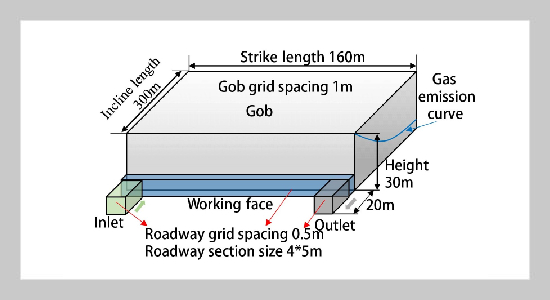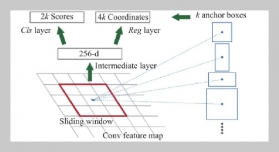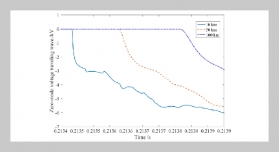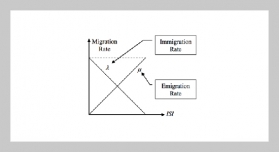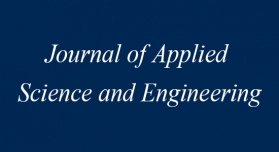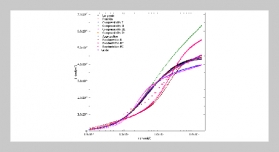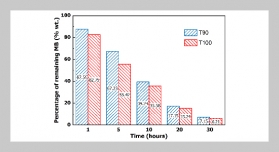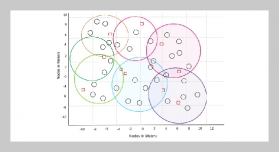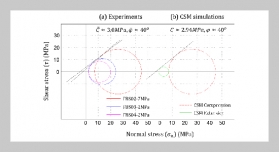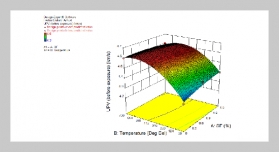- [1] W. Qin, J. Xu, and G. Hu, (2015) “Optimization of abandoned gob methane drainage through well placement selection" Journal of Natural Gas Science and Engi�neering 25: 148–158. DOI: 10.1016/j.jngse.2015.05.004.
- [2] S. Yang, B. Zhou, and C. Wang, (2021) “Investiga�tion on coal spontaneous combustion in the gob of Y type ventialtion caving face: A case study" Process Safety and Environmental Protection 148: 590–603. DOI: 10.1016/j.psep.2020.11.024.
- [3] J. Antoni, J. Brodny, and M. Tutak, (2018) “The impact of airway geometry on the distribution of methane concen�trations at the outlet from a longwall" Mechanics 24(5): 695–702. DOI: 10.5755/j01.mech.24.5.21194.
- [4] M. Tutak and J. Brodny, (2019) “The impact of the strength of roof rocks on the extent of the zone with a high risk of spontaneous coal combustion for fully pow�ered longwalls ventilated with the y-type system—A case study" Applied Sciences 9(24): 5315. DOI: 10.3390/app9245315.
- [5] W. Cheng, L. Xin, G. Wang, Z. Liu, and W. Nie, (2015) “Analytical research on dynamic temperature field of overburden in goaf fire-area under piecewise-linear third boundary condition" International Journal of Heat and Mass Transfer 90: 812–824. DOI: 10.1016/j.ijheatmasstransfer.2015.07.012.
- [6] C. Ting-xiang, Z. Shi-xuan, X. Yong-liang, and Z. Zhi�jun, (2011) “Research on the coupling effects between stereo gas extraction and coal spontaneous combustion" Procedia Engineering 26: 218–227. DOI: 10.1016/j.proeng.2011.11.2161.
- [7] T. Chu, P. Li, and Y. Chen, (2019) “Risk assessment of gas control and spontaneous combustion of coal under gas drainage of an upper tunnel" International Journal of Mining Science and Technology 29(3): 491–498. DOI: 10.1016/j.ijmst.2018.05.002.
- [8] C. Ö. Karacan, (2015) “Analysis of gob gas venthole production performances for strata gas control in longwall mining" International Journal of Rock Mechanics and Mining Sciences 79: 9–18. DOI: 10.1016/j.ijrmms.2015.08.001.
- [9] D. Ma, X. Miao, G. Jiang, H. Bai, and Z. Chen, (2014) “An experimental investigation of permeability measure�ment of water flow in crushed rocks" Transport in Porous Media 105: 571–595. DOI: 10.1007/s11242-014-0385-5.
- [10] C. Wang, S. Yang, and X. Li, (2018) “Simulation of the hazard arising from the coupling of gas explosions and spontaneously combustible coal due to the gas drainage of a gob" Process Safety and Environmental Protection 118: 296–306. DOI: 10.1016/j.psep.2018.06.028.
- [11] P. Rong-kun, L. Chang, Y. Ke, and Y. Ming-gao, (2011) “Distribution regularity and numerical simulation study on the coal spontaneous combustion “three zones” under the ventilation type of ventilation type of U + J" Procedia Engineering 26: 704–711. DOI: 10.1016/j.proeng.2011.11.2226.
- [12] B. Qin, L. Li, D. Ma, Y. Lu, X. Zhong, and Y. Jia, (2016) “Control technology for the avoidance of the simultaneous occurrence of a methane explosion and spontaneous coal combustion in a coal mine: A case study" Process Safety and Environmental Protection 103: 203–211. DOI: 10.1016/j.psep.2016.07.005.
- [13] J. Liu, J. Gao, M. Yang, D. Wang, and L. Wang, (2019) “Numerical simulation of parameters optimization for goaf gas boreholes" Advances in Civil Engineering 2019: 1–13. DOI: 10.1155/2019/3891080.
- [14] Q.-w. Deng, X.-h. Liu, C. Lu, Q.-Z. Lin, and M.-g. YU, (2013) “Numerical simulation of spontaneous oxidation zone distribution in goaf under gas stereo drainage" Pro�cedia Engineering 52: 72–78. DOI: 10.1016/j.proeng.2013.02.108.
- [15] Z. Qin, L. Yuan, H. Guo, and Q. Qu, (2015) “Investi�gation of longwall goaf gas flows and borehole drainage performance by CFD simulation" International Journal of Coal Geology 150: 51–63. DOI: 10.1016/j.coal.2015.08.007.
- [16] M. Tang, B. Jiang, R. Zhang, Z. Yin, and G. Dai, (2016) “Numerical analysis on the influence of gas extraction on air leakage in the gob" Journal of Natural Gas Science and Engineering 33: 278–286. DOI: 10.1016/j.jngse.2016.05.006.
- [17] S. Yang, X. Hu, W. V. Liu, J. Cai, and X. Zhou, (2018) “Spontaneous combustion influenced by surface methane drainage and its prediction by rescaled range analysis" In�ternational Journal of Mining Science and Technol�ogy 28(2): 215–221. DOI: 10.1016/j.ijmst.2017.12.004.
- [18] T. Xia, F. Zhou, X. Wang, Y. Zhang, Y. Li, J. Kang, and J. Liu, (2016) “Controlling factors of symbiotic disaster between coal gas and spontaneous combustion in longwall mining gobs" Fuel 182: 886–896. DOI: 10.1016/j.fuel.2016.05.090.
- [19] L. Yuan and A. C. Smith, (2012) “The effect of venti�lation on spontaneous heating of coal" Journal of Loss Prevention in the Process Industries 25(1): 131–137. DOI: 10.1016/j.jlp.2011.07.007.
- [20] J. Brodny and M. Tutak, (2019) “Forecasting the distri�bution of methane concentration levels in mine headings by means of model-based tests and in-situ measurements" Archives of Control Sciences 29(1): 25–39.
- [21] X. Ma, M. He, J. Wang, Y. Gao, D. Zhu, and Y. Liu, (2018) “Mine strata pressure characteristics and mecha�nisms in gob-side entry retention by roof cutting under medium-thick coal seam and compound roof conditions" Energies 11(10): 2539. DOI: 10.3390/en11102539.
- [22] M. Xingen, H. Manchao, W. Yajun, Z. Yong, Z. Ji�abin, and L. Yuxing, (2018) “Study and application of roof cutting pressure releasing technology in retracement channel roof of Halagou 12201 working face" Mathe�matical Problems in Engineering 2018: 1–15. DOI: 10.1155/2018/6568983.
- [23] Y. Wang, Y. Gao, E. Wang, M. He, and J. Yang, (2018) “Roof deformation characteristics and preventive tech�niques using a novel non-pillar mining method of gob�side entry retaining by roof cutting" Energies 11(3): 627. DOI: 10.3390/en11030627.
- [24] Q. Wang, M. He, J. Yang, H. Gao, B. Jiang, and H. Yu, (2018) “Study of a no-pillar mining technique with automatically formed gob-side entry retaining for longwall mining in coal mines" International Journal of Rock Mechanics and Mining Sciences 110: 1–8.
- [25] X. Li, C. Wang, Y. Chen, J. Tang, and Y. Li, (2018) “Design of gas drainage modes based on gas emission rate in a gob: a simulation study" Arabian Journal of Geo�sciences 11: 1–12. DOI: 10.1007/s12517-018-3830-x.
- [26] S. Guo, Y. Tai, Z.-W. Wang, B.-W. Shi, and K. Yang, (2021) “Fracture characteristics of basic roof and mecha�nism of strata behavior in a pillarless working face" Jour�nal of Geophysics and Engineering 18(6): 875–889. DOI: 10.1093/jge/gxab059.
- [27] Q. Liu, B. Lin, Y. Zhou, and Y. Li, (2022) “Porosity model of the goaf based on overlying strata movement and deformation" Environmental Earth Sciences 81(7): 214. DOI: 10.1007/s12665-022-10329-5.
- [28] S. Wang, X. Li, and D. Wang, (2016) “Void fraction distribution in overburden disturbed by longwall mining of coal" Environmental Earth Sciences 75: 1–17. DOI: 10.1007/s12665-015-4958-6.
- [29] Z. Song, J. Zhang, L. Zhang, X. Dong, W. Niu, and Y. Zhang, (2022) “The permeability properties of bedded coal and rock: Review and new insights" Energy Science & Engineering 10(4): 1544–1565. DOI: 10.1002/ese3.1092.
- [30] C. Ting-Xiang, L. Chun-Sheng, and Y. Ming-Gao, (2012) “Influential effect on spontaneous combustion of float coal induced by gas extraction in upper roadway" Journal of Mining and Safety Engineering 29(3): 421.
